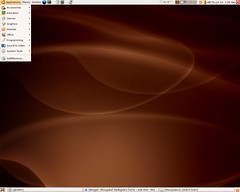
My Ubuntu desktop (with the application menu open);
larger versions here and here.
I installed Ubuntu 6.06 on my primary home machine about three weeks ago (more background here and here), and in that time I've discovered a lot of little things that I like about Ubuntu. Since I suspect that few of my readers use Ubuntu or Linux, I thought I'd post a short illustrated tour of some of my favorite Ubuntu features:
- The clock. It shows the time, of course, but it also shows the day of the week and date. Even more useful, single-clicking on the clock brings up a little calendar of the current month that highlights today's date and politely stays on top of other applications until I click it again. It's insanely useful for working with dates.
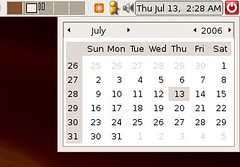
The calendar popup of Ubuntu's clock. - The top panel. Ubuntu comes default with two panels; they function much like Windows' task bar (they contain buttons for each of the currently running programs, links to start programs, a clock, etc.), but having two panels means that they can hold much more. And there's much more for them to hold, as Ubuntu has a number of useful little applets (e.g., search bars, timers, weather forecasts, stock tickers, sticky notes) that can be docked onto the panels.

Labeled screencap of my top panel (with the applications menu open); larger version is here.
I've got my bottom panel set up to hold buttons for currently running programs, the recycle bin, and a button to minimize all programs (see the screenshot at the top of this post). That leaves the top panel to hold things like quick-start icons for programs (e.g., Firefox, gEdit, the calculator); my choice of other applets (I've got a timer and one showing the current weather conditions); and menus that contain links to my programs, important locations on my computer, and my system preferences (the menus "Applications," "Places," and "System," respectively).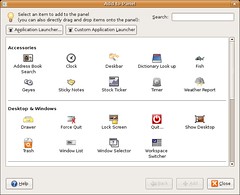
Some of the applets that can be added to Ubuntu's panels; larger version is here. - Multiple workspaces. X-windows (the graphical interface behind Ubuntu) allows users to have multiple virtual workspaces. Each workspace is somewhat akin to having a different monitor; programs open on one workspace don't show up on other workspaces (unless you want them to). All I have to do to switch between workspaces is click on a little image of the workspace in the upper-right portion of the screen (the workspace switcher labeled in the image above). This means I can have my web browser (and related programs) open on one workspace, my photos open on another, and my course syllabi open on yet another. It's insanely useful.
- The application menu. This menu (equivalent to Windows' Start Menu) immediately brings up a list of program categories; I don't have to click on Start, then select another menu to see the list of categories. The menu also comes with far fewer categories than a default Windows install, and new programs almost never create new categories (they just fit within existing ones). Thus, to use a Windows example, I don't have to remember that Photoshop is made by Adobe to find it in my Start menu; the Ubuntu equivalent of Photoshop is just placed in the "Graphics" category. You can see the application menu's default categories by looking at the screenshot above.
- The add/remove applications menu. To install new programs all I have to do is go to the "Applications" menu and select "Add/Remove ..." (see the screenshot above). This brings up a friendly graphical interface that allows me to browse through hundreds of free-to-install programs.
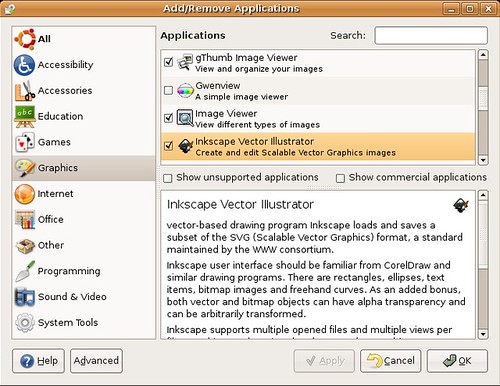
Ubuntu's add/remove applications menu.
The program is extremely simple to use; you can either browse through the categories or search for what you want (by package name or program description, e.g., searching for "photo" brings up many image manipulation programs). To install a program all you have to do is put a check mark next to what you want and then click "OK." Ubuntu will ask for your password, automatically download and install the program, and then show you a dialog saying the program was installed. Just to emphasize the point, everything listed within this menu is absolutely free to install, free of wacky EULAs, and has absolutely no ads.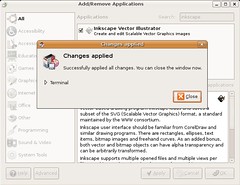
Program installed! - The ability to add scripts. It is relatively easy to write scripts for Unix-based operating systems, and Ubuntu is no exception. Scripts are extremely powerful tools (they can do just about anything that can be done from a command line), and thus being able to add them to Ubuntu's GUI is very useful. A few days ago I modified a pre-existing script so that I could bulk resize and rename images from within Ubuntu's file browser (without opening any graphics programs; see this post for more details); it has already saved me a bunch of time. Here's a screenshot showing how easy it is to activate the script:

Choosing the Resize_images script from within Nautilus (Ubuntu's file browser) by right-clicking on the image.



No comments:
Post a Comment